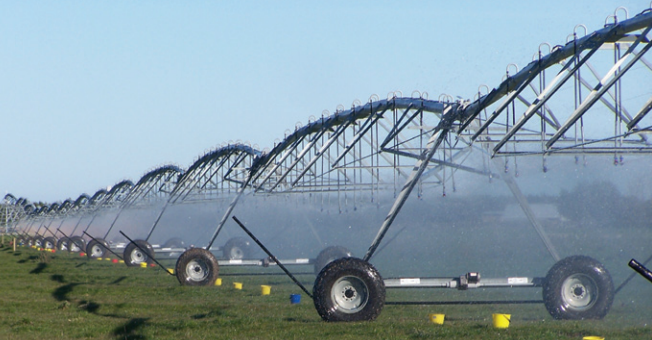How to decide when to autumn irrigate
 PRODUCTION ADVICE - FEBRUARY 2021 - AGRONOMY
PRODUCTION ADVICE - FEBRUARY 2021 - AGRONOMY
By Adrian Smith
Senior Land Services Officer, Mixed Farming Systems
P: 03 5881 9932 | M: 0447 778 515 | E: adrian.smith@lls.nsw.gov.au
 The autumn start-up of winter pastures and forage crops is a challenging and often exciting time. It heralds the change of season, but more importantly, sets up your feed supplies heading into winter.
The autumn start-up of winter pastures and forage crops is a challenging and often exciting time. It heralds the change of season, but more importantly, sets up your feed supplies heading into winter.
There are many factors that will influence your decision about when (and even if!) to start watering – immediate feed requirements, amount of irrigation water available, your irrigation layouts, likelihood of rain, and the different mix of pastures/crops you have.
And this year may throw another challenge into the mix – (late) summer rainfall can prove quite the conundrum for irrigators of autumn pastures and forage crops.
Sow on soil temperature – not to a date!
Perhaps the most important consideration is temperature - both ambient and soil. Hot conditions in conjunction with irrigation during the germination/establishment period can reduce germination of many species by up to 90 per cent due to scalding.
High soil temperatures can limit germination, even with adequate soil moisture. Within species, different varieties have different tolerances for soil temperature at emergence.
As a general guide:
Forage type | Soil temperature and germination |
Annual clover – eg. sub, balansa etc | Germination percentage greatly reduced at soil surface temperatures above 25°C. |
Annual clover – shaftal (or Maral) | Germination is not affected by soil surface temperatures up to 35°C. |
Ryegrass | Germination reduced at soil temperature over 25°C. |
Cereals | Normally satisfactory within a surface soil temperature range of 10°C to 25°C (some varieties can germinate at higher soil surface temperatures). |
Within the cereals, oats are the most tolerant of higher temperatures, and satisfactory germination of several oat varieties will occur at soil temperatures up to 30°C. It’s important to remember if sowing cereals into warm soils that the coleoptile is likely to be shorter, so sow no deeper than 4-5 cm.
To get an indication of maximum daily soil temperature, you can place a thermometer at the planting depth mid-to-late-afternoon. If you think you might look a bit silly sticking a thermometer into the ground as the neighbour drives past, the most practical indicator is when daily average air temperature (daytime maximum temperature + the night minimum temperature divided by 2) is less than 25°C for a period of 7-10 days!
How much feed can be produced?
The following table provides some clarity about how much feed (as DM, or dry matter) you could expect to produce from a well-managed annual (subclover-based) pasture from different irrigation regimes up until mid-winter.
Within the cereals, oats are the most tolerant of higher temperatures, and satisfactory germination of several oat varieties will occur at soil temperatures up to 30°C. It’s important to remember if sowing cereals into warm soils that the coleoptile is likely to be shorter, so sow no deeper than 4-5 cm.
To get an indication of maximum daily soil temperature, you can place a thermometer at the planting depth mid-to-late-afternoon. If you think you might look a bit silly sticking a thermometer into the ground as the neighbour drives past, the most practical indicator is when daily average air temperature (daytime maximum temperature + the night minimum temperature divided by 2) is less than 25°C for a period of 7-10 days!
How much feed can be produced?
The following table provides some clarity about how much feed (as DM, or dry matter) you could expect to produce from a well-managed annual (subclover-based) pasture from different irrigation regimes up until mid-winter.
Source: Murray Dairy, 2016.
While this data suggests there is little difference in terms of the efficiency of production (i.e. the tonnes of dry matter produced per ML of water applied), local data from the irrigated sub check work conducted by NSW Agriculture clearly showed an early February start was the least efficient, with a mid-to-late March start-off being the most efficient in terms of dry matter production/ML of water use.
Of course, this doesn’t tell the full story, as quality (not just tonnes) of feed produced is important as well. Starting off early may result in germination of summer-growing species of lower quality. But the graph provides a pretty good indication of the relative productivity of each strategy.
Further, a recent review done by Rogers et al. (2017) suggested that well managed irrigated subclover and ryegrass pastures can produce 8-15 t DM/ha over the season, and dual-purpose cereals may produce up to 3 t DM/ha over the autumn/winter period, and a further 7 t DM/ha in the spring as a hay or silage cut.
Obviously, the significant input into each of these strategies is the volume of irrigation water used in the autumn with each strategy. As an example (and assuming little effective early autumn rainfall):
- A late February start-off may require 4-5 irrigations, using 3-5 ML/ha
- A mid-March start-off may require 3-4 irrigations, using 2.5-4 ML/ha
- A mid-April start-off may require 2 irrigations, using 1.5-2.5 ML/ha
Understanding the likely water requirements of your intended approach is important. You can then compare different approaches – for example, a ‘watering-up’ of a cereal using one irrigation compared with annual pastures requiring maybe four, and the relative risks and potential production can then be evaluated and factored in – enabling you to develop the right mix of irrigation and species for your situation.
No matter what your start-off strategy is, the timing of the follow-up irrigation – particularly of small-seeded pastures – is critical. In this instance, the time between the first and second irrigation should be no longer than 4-10 days. Longer irrigation intervals at this critical time will not save water. But what they will do is stress the emerging seedlings, resulting in poor germination and establishment, and ultimately lower production.
What do I do with late summer rains?
Hopefully rejoice in it – it may be the start of the autumn break!
But in all seriousness, mid-late-summer rainfall can often be really challenging. Small rainfall events aren’t necessarily the problem. It is those larger events (which some have seen this February – with potentially more to follow) that can cause real headaches. Those events that lead to germination of winter-growing pasture species before the ideal time are the most challenging – if germination is good, do you then irrigate them to keep them going?
(Just as an aside – one of the best ways to get real value from these rain events is to incorporate perennials into your system. Whether it be lucerne, the native grasses or something else – having perennials as part of your feedbase is perhaps the best way to get real value out of summer rains. Apart from the extra feed they produce, they compete with summer weeds, and help to maintain groundcover – win, win, win in my book!).
What’s right for you?
That’s the $64 question!
Ultimately it will be a combination of production needs, water availability, types of species (and their different growth habits), agronomy, the season (and if and when the autumn break arrives!), soil temperatures, your layouts and your management.
There is not one right answer – it is about weighing up all these factors, doing a bit of homework and planning, and then working out what strategy (or mix of strategies) is right for your business this particular season.